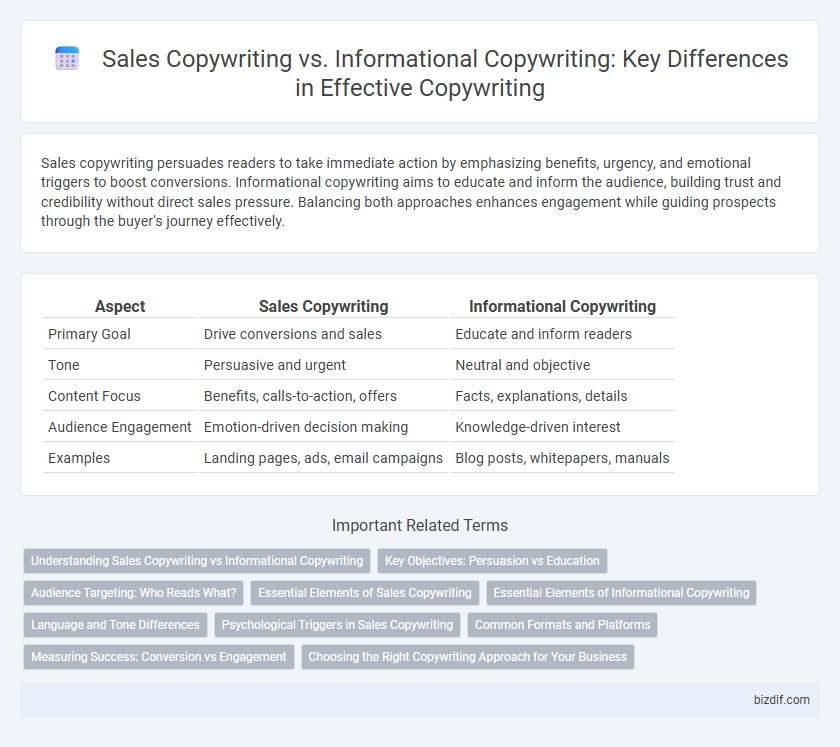Sales copywriting persuades readers to take immediate action by emphasizing benefits, urgency, and emotional triggers to boost conversions. Informational copywriting aims to educate and inform the audience, building trust and credibility without direct sales pressure. Balancing both approaches enhances engagement while guiding prospects through the buyer's journey effectively.
Table of Comparison
| Aspect | Sales Copywriting | Informational Copywriting |
|---|---|---|
| Primary Goal | Drive conversions and sales | Educate and inform readers |
| Tone | Persuasive and urgent | Neutral and objective |
| Content Focus | Benefits, calls-to-action, offers | Facts, explanations, details |
| Audience Engagement | Emotion-driven decision making | Knowledge-driven interest |
| Examples | Landing pages, ads, email campaigns | Blog posts, whitepapers, manuals |
Understanding Sales Copywriting vs Informational Copywriting
Sales copywriting focuses on persuading readers to take immediate action, emphasizing emotional triggers and clear calls-to-action to drive conversions and boost revenue. Informational copywriting aims to educate and inform the audience by providing valuable, well-researched content that builds trust and authority over time. Understanding the distinction helps marketers tailor strategies to either engage potential customers through compelling sales messages or nurture leads with informative content.
Key Objectives: Persuasion vs Education
Sales copywriting aims to persuade readers to take immediate action, often by highlighting benefits, creating urgency, and triggering emotional responses. Informational copywriting focuses on educating the audience by providing valuable, detailed content that builds trust and authority over time. Effective marketing strategies leverage sales copy to drive conversions and informational copy to nurture and inform potential customers.
Audience Targeting: Who Reads What?
Sales copywriting targets potential buyers by using persuasive language and emotional triggers to drive immediate action, appealing primarily to decision-makers and consumers ready to make a purchase. Informational copywriting attracts a broader audience seeking in-depth knowledge or problem-solving insights, including researchers, students, and early-stage buyers gathering information. Understanding the audience's intent and stage in the buyer's journey is crucial for crafting effective sales copy that converts and informational copy that educates.
Essential Elements of Sales Copywriting
Sales copywriting centers on persuasive language that drives action, incorporating essential elements such as a compelling headline, clear value proposition, strong call-to-action, and emotional appeal to influence buying decisions. It emphasizes benefits over features and uses urgency or scarcity to motivate immediate responses. Unlike informational copywriting that educates, sales copywriting aims to convert prospects into customers by addressing pain points and offering solutions directly tied to consumer desires.
Essential Elements of Informational Copywriting
Informational copywriting centers on clarity, accuracy, and value, providing readers with well-researched facts and actionable insights to build trust and authority. Essential elements include a clear headline, concise and structured content, and credible sources that enhance the message's reliability. This type of copy aims to educate and inform, focusing on user intent and delivering relevant information without overt sales pressure.
Language and Tone Differences
Sales copywriting employs persuasive and emotive language designed to drive immediate action, using powerful calls-to-action and urgency-driven phrases. Informational copywriting focuses on clear, factual, and neutral tone, prioritizing accuracy and educating the reader without overt persuasion. The tone in sales copywriting is energetic and compelling, while informational copywriting maintains an objective and trustworthy voice.
Psychological Triggers in Sales Copywriting
Sales copywriting leverages psychological triggers such as scarcity, social proof, and urgency to drive consumer action and increase conversion rates. Informational copywriting prioritizes clarity and education, aiming to build trust and authority without aggressive persuasion tactics. Mastering psychological triggers in sales copywriting enhances emotional engagement, prompting quicker decision-making and boosting sales performance.
Common Formats and Platforms
Sales copywriting commonly appears in formats such as email campaigns, landing pages, and social media ads designed to drive conversions and immediate action. Informational copywriting is frequently found in blog posts, whitepapers, and FAQs aimed at educating the audience and building authority. Both formats utilize platforms like websites, email marketing software, and social networks, but sales copy prioritizes persuasion while informational copy emphasizes clarity and value.
Measuring Success: Conversion vs Engagement
Sales copywriting measures success primarily through conversion rates, tracking how effectively the text turns readers into customers or prompts specific actions such as purchases or sign-ups. Informational copywriting focuses on engagement metrics like time spent on page, social shares, and comments to gauge how well the content educates or informs the audience. Both types use analytics tools like Google Analytics and A/B testing to refine strategies based on conversion data and user interaction patterns.
Choosing the Right Copywriting Approach for Your Business
Sales copywriting drives conversions by creating urgent, persuasive messages that highlight product benefits and calls to action, ideal for direct response campaigns. Informational copywriting builds trust and authority by providing valuable, educational content that nurtures leads and supports long-term relationship building. Selecting the right approach depends on your business goals: use sales copy to boost immediate sales and informational copy to establish credibility and engage your audience over time.
Sales Copywriting vs Informational Copywriting Infographic

 bizdif.com
bizdif.com